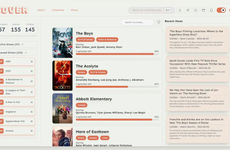
The 'How is the TV Landscape Changing' Infographic Tracks the Progress of TV
Corinne Guirgis — January 10, 2012 — Tech
References: readwriteweb & holykaw.alltop
It's no secret that the television has changed dramatically with the rise of Internet streaming, and the 'How is the TV Landscape Changing' Infographic tracks this progression of digital media and television. While it appears to have been a gradual change, technological developments such as DVR, YouTube, Netflix and Social Television seem to have built on each other to create the current television empire in which society lives.
The current status of television viewing is such that most viewers are not even fully immersed in the program they are watching while they watch it. The infographic suggests that 88% of viewers are mobile multitasking while they watch television! These are only a few of the striking television statistics offered by the 'How is the TV Landscape Changing' Infographic.
The current status of television viewing is such that most viewers are not even fully immersed in the program they are watching while they watch it. The infographic suggests that 88% of viewers are mobile multitasking while they watch television! These are only a few of the striking television statistics offered by the 'How is the TV Landscape Changing' Infographic.
Trend Themes
1. Streaming Dominance - The rise of Internet streaming has taken over traditional television viewing, creating disruption opportunities for businesses in the streaming industry.
2. Multitasking TV - A majority of TV viewers are multitasking while watching TV, suggesting new opportunities for businesses to incorporate second-screen experiences or gamification opportunities associated with TV programming.
3. Social Television - Social media platforms like Twitter and Facebook have become integral in the way viewers discuss and engage with TV programming, creating a new space for businesses to explore innovative advertising and audience engagement strategies.
Industry Implications
1. Streaming Services - The rise of internet streaming as the preferred medium for TV viewership paves the way for new entrants and disruptors to challenge traditional bigwigs like Netflix, Amazon and Hulu, or propelling original content creation businesses.
2. Interactive TV - With viewers actively multitasking while watching TV, businesses can leverage second-screen experiences to create interactive TV experiences, leading to disruptive innovation opportunities in the fields of media and advertising.
3. Social Media Advertising - Social media platforms like Twitter and Facebook offer a unique space for businesses to engage with viewers of specific TV programs, creating disruptive innovation opportunities for targeted and interactive advertising campaigns.
5.5
Score
Popularity
Activity
Freshness























